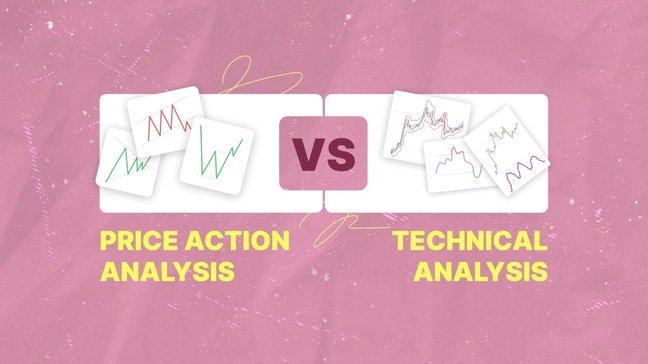Price Action Analysis Vs Technical Analysis in Forex Trading
Some beginners mistakenly consider price action and technical analysis the same thing. Well, they are different. The two methodologies do have some similar factors. On the other hand, they rely on different Forex charts and patterns, Forex indicators, and other components of a so-called “technical study”.

Today, we have two major approaches used by currency traders. The first one involves market participants who apply Forex trading techniques based on technical indicators and chart patterns. On the other side, we have traders who mainly use raw price action techniques.
Which one is the best to choose and why? What are the differences between these two approaches? Let’s find this out.
Technical Analysis Methods in Forex Trading
The first thing we need to mention is that all methods to conduct technical analysis are not created equally. In simpler words, not all data generated by TA is a good thing to study. At the same time, price action fans rely mainly on raw price charts and information about the asset value they generate.
Forex charts come in hundreds of different patterns. It would be silly of us to think we can learn all of them. What’s more, technical indicators come with millions of settings and configurations. The key point is that none of those tools should be used without taking into account price action.
up to 200%

from 0 pips

Trading platform

So, price action analysis is the factor we simply cannot ignore even when relying solely on TA. Otherwise, retail traders will never be able to avoid failures and huge financial losses, especially in the long run.
How to Avoid the “Technical” Noise?
The main problem with the majority of technical analysis tools is the fact they produce too much “noise”. It means they generate too many factors that will not be necessary for a particular trader. On the other hand, some traders cannot sort our valuable data from that noise. It results in a misleading understanding of what is happening in the market.
In the end, traders find themselves with tons of unnecessary variables that often make no sense. Moreover, some of the most popular indicators are nothing more than derivatives of the price action. Why would one ever want to explore something derived from the price action instead of analyzing the raw price action first?
The answer is very simple. The main downside of the price action is that it is very difficult to automate. All actions and research must be fulfilled manually. It requires specific skills and knowledge most beginners usually lack.
Another obstacle is that price action does not show you how the price or market will move in the future. It actually states the current situation as well as how the price has been moving before you entered the market. In this perspective, technical analysis delivers a bit more flexibility, as traders can make predictions to find better short-term opportunities for entering the market with a winning position.
Price Action Vs Technical Analysis: Which One to Choose
It is pretty hard to say which one is better and why. On the one hand, the price action approach is a great strategy to filter the noise you come across in numerous free books and web sources that promise “comprehensive” education.
The key to success when using any of the methodologies is to clear up all the crap and keep it condensed down to what really works and what really makes sense under the given market conditions. Price action, price movement, historical data, and market sentiments are the logical factors behind Forex trading. These are the factors that move the market.
The bad news for beginners is that not all traders have the ability to read the market like it's open using price action. Oppositely, other investors are skilled enough to use technical indicators to identify a potentially profitable trading opportunity. The methodology also calls for specific experience and understanding of how TA works.
Any analysis helps to map the market. Traders use a set of bars and price patterns to generate signals for market entry. The generated data makes it possible to a lesser extent exit as well. It can be done with either price action or TA.
All you need is to patiently wait until the confluence of necessary factors will eventually align forming a perfect entry opportunity. Another challenge here is learning how to read trading signals. If you learn to avoid trash and focus on valuable data instead, your trades will quickly gain success.
The Bottom Line
Experienced Forex traders know that the key to success is to be diverse and adapt to the changing market. In our today’s context, it means not locking yourself to a single approach. Do not assign a specific role to your Forex strategies. There is nothing wrong with using different approaches or even combining them.
At some point, even price action will show nothing to trade with. On the other hand, the chances of missing a great entry opportunity are high. This is where indicators can be a better alternative, as they will highlight something you could have missed earlier. At least, you can try several data-based trades instead of waiting.
This material does not contain and should not be construed as containing investment advice, investment recommendations, an offer of or solicitation for any transactions in financial instruments. Before making any investment decisions, you should seek advice from independent financial advisors to ensure you understand the risks.
